
BC Outdoor Odyssey
"Trumpeter Swans - Giant Majestic White Birds;
A British
Columbia Waterfowl Management Success Story."
with Barry M. Thornton
Sitting in my blind this past winter I have watched a truly unique
British Columbia wildlife spectacle, the return of the Trumpeter Swans
to the Comox Valley on Vancouver
Island. I can remember when, only twenty-five years ago, that
the Comox Valley was host to only three of these magnificent birds.
They were rare and endangered at that time, less than 10,000 in their
total world population, scarce like the 'Spotted Owl' is today in
our old growth forests.
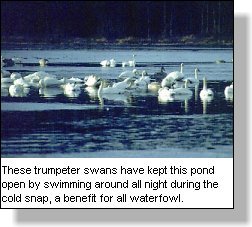 At
that time, as a Director of the B.C. Wildlife Federation, I was asked
by the Canadian Wildlife Service to help them with a most serious
problem. These particular swans had discovered the fall seed corn
planted on the Courtenay River dike flats farm fields and, like meticulous
sewing machines, were marching up and down the rows gorging themselves
on the sprouting corn. Because I drove by the fields each morning
and afternoon, my task was to fire a flare pistol over the heads of
the swans. The flare, on most occasions, was ample to startle the
birds and send them back to the river estuary. Once broken of this
feeding habit they finally moved to other 'greener' valley fields
to winter. At
that time, as a Director of the B.C. Wildlife Federation, I was asked
by the Canadian Wildlife Service to help them with a most serious
problem. These particular swans had discovered the fall seed corn
planted on the Courtenay River dike flats farm fields and, like meticulous
sewing machines, were marching up and down the rows gorging themselves
on the sprouting corn. Because I drove by the fields each morning
and afternoon, my task was to fire a flare pistol over the heads of
the swans. The flare, on most occasions, was ample to startle the
birds and send them back to the river estuary. Once broken of this
feeding habit they finally moved to other 'greener' valley fields
to winter.
There was one tragedy for this wintering family. One misty February
weekend morning one bird was found where it had collided with the
power lines along the dike road, dying instantly when it was electrocuted.
But, this one bird has served an even greater purpose these past twenty-five
years. It was mounted by the Canadian Wildlife Service and presented
to schools in the Valley. It still visits various school libraries
now missing a few feathers where many hundreds, even thousands of
students have gently stroked the creamy white feathers . It still
remains a beautiful educational example of this largest of our North
American waterfowl.
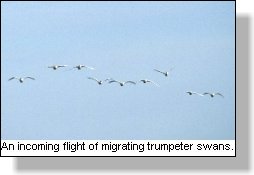 I
like to be poetic and think that from these two came the many. But,
I know that my singular efforts were only minor in the total well
being of these striking birds. The species was on the brink of extinction
but, it had not yet reached that state when there were too few to
find others to mate and to reproduce. I recall even earlier, in the
late 1950's, that the B.C. Wildlife Federation initiated a $500 reward
for information leading to the conviction of anyone who killed one
of these rare birds. It was highly successful for it created the early
vital and effective publicity which provided necessary increased protection. I
like to be poetic and think that from these two came the many. But,
I know that my singular efforts were only minor in the total well
being of these striking birds. The species was on the brink of extinction
but, it had not yet reached that state when there were too few to
find others to mate and to reproduce. I recall even earlier, in the
late 1950's, that the B.C. Wildlife Federation initiated a $500 reward
for information leading to the conviction of anyone who killed one
of these rare birds. It was highly successful for it created the early
vital and effective publicity which provided necessary increased protection.
Fortunately, like the Canada
goose, the Trumpeter
Swan has adapted well to a rural and urban mix of wintering habitat,
so much so that when it increased it's population above 10,000, it
was moved from the 'endangered' wildlife category to the 'threatened'
category. In the late 1980's, with an even greater increase, it was
moved again to the 'vulnerable' category. Today it has a Pacific Flyway
population of over 14,000 and a world population of over 30,000.
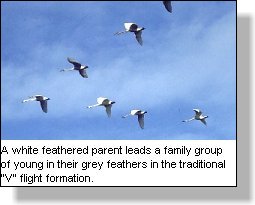 Trumpeter
Swans are the largest waterfowl found in North America. They have
an average weight of 11-13 kilos ( 28 - 33 lbs) and mate for life
when they are three years or older. Adult birds tend to be a cream
white in color while young of the year, signets, tend to have grey
colored feathers. Their name comes from the distinct 'trumpet' call
of the adults. In my blind I have been fortunate to watch their incredible
flights from field to field and I remain amazed at how their large
black paddle webbed feet act as landing gear when they glide and splash
into various ponds and flooded fields. As they fly overhead the wind
can be heard whistling through their powerful flight feathers in a
sound unlike any other in the waterfowl world. Trumpeter
Swans are the largest waterfowl found in North America. They have
an average weight of 11-13 kilos ( 28 - 33 lbs) and mate for life
when they are three years or older. Adult birds tend to be a cream
white in color while young of the year, signets, tend to have grey
colored feathers. Their name comes from the distinct 'trumpet' call
of the adults. In my blind I have been fortunate to watch their incredible
flights from field to field and I remain amazed at how their large
black paddle webbed feet act as landing gear when they glide and splash
into various ponds and flooded fields. As they fly overhead the wind
can be heard whistling through their powerful flight feathers in a
sound unlike any other in the waterfowl world.
The Pacific coast provides wintering locations for about 14,000 Trumpeter
Swans. These locations are scattered throughout the Northwest states
and southwestern B.C. The Comox Valley on Vancouver Island has the
greatest concentration and winters about 3000 birds.
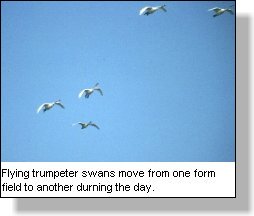 The
concentration of birds is not without its problems and, as I mentioned
earlier, the birds often wreck havoc on farmlands. The Comox
Valley Waterfowl Project, a program sponsored by Duck Unlimited
with funding from the Canadian Wildlife Service has three objectives
according to Ducks Unlimited. These objectives; public communications
& education, a 'scare' program, and, planting of cover crops, are
coordinated by a Waterfowl Project Coordinator. It is worthy of note
that funding for most CWS wetland waterfowl projects comes from waterfowler
purchase of federal government Migratory Game Bird Hunting Permits
and Donations by Duck Unlimited. The
concentration of birds is not without its problems and, as I mentioned
earlier, the birds often wreck havoc on farmlands. The Comox
Valley Waterfowl Project, a program sponsored by Duck Unlimited
with funding from the Canadian Wildlife Service has three objectives
according to Ducks Unlimited. These objectives; public communications
& education, a 'scare' program, and, planting of cover crops, are
coordinated by a Waterfowl Project Coordinator. It is worthy of note
that funding for most CWS wetland waterfowl projects comes from waterfowler
purchase of federal government Migratory Game Bird Hunting Permits
and Donations by Duck Unlimited.
The three Waterfowl Management Project objectives are as follows;
- Communication and Education goals; To produce a project newsletter
to reduce the gap between agriculture and the public. As well to
support the Comox Valley Annual Swan Festival to generate public
awareness of problems between swans and landowner. The festival
objective is to set up a wildlife legacy fund. aimed at Trumpeter
swan management initiatives. To produce an educational colouring
book which will be available at the festival - free.
- Cover crop promotion: Trumpeter swans have selective palates when
feeding on grasses. They like the succulent new growth of perennial
rye grasses and orchard grass, these are the local dairy pasture
grasses. The program promotes cover cropping of annual rye grasses.
Cooperator landowners are given $25 per acre to plant this cover
but it is not a compensation measure. Currently 35 farmer/landowners
participate in the program, 11 of whom are cooperators with a total
of 500 acres in this annual cover crop.
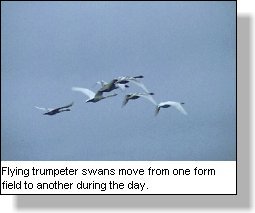
- Scare tactics. With the new cover crops available there are places
for the Trumpeters to go and they are able to be chased from places
the farmers wish to protect. Black flags are used as a scarecrow
because it is an obstruction in the field which makes the swans
uneasy. Strings of multi -coloured pennants and sections of red
and silver flash tape are also used. They all work on the effect
they have on the trumpeter's landing, take off, and general uneasiness.
Coordinated management, farmer land-owner support, and public awareness
have done much to promote the tenuous state of these gigantic birds
in recent years. The sight of open fields along the Island Highway,
white with their majesty, is a sign of the success of these three
goals. Now, from Late October through March, as I watch from my blind,
I am constantly reminded of the concentrated efforts of many to enhance
one more of British Columbia's special wildlife species.
© Copyright Barry M. Thornton
Barry M. Thornton
|




 At
that time, as a Director of the B.C. Wildlife Federation, I was asked
by the Canadian Wildlife Service to help them with a most serious
problem. These particular swans had discovered the fall seed corn
planted on the Courtenay River dike flats farm fields and, like meticulous
sewing machines, were marching up and down the rows gorging themselves
on the sprouting corn. Because I drove by the fields each morning
and afternoon, my task was to fire a flare pistol over the heads of
the swans. The flare, on most occasions, was ample to startle the
birds and send them back to the river estuary. Once broken of this
feeding habit they finally moved to other 'greener' valley fields
to winter.
At
that time, as a Director of the B.C. Wildlife Federation, I was asked
by the Canadian Wildlife Service to help them with a most serious
problem. These particular swans had discovered the fall seed corn
planted on the Courtenay River dike flats farm fields and, like meticulous
sewing machines, were marching up and down the rows gorging themselves
on the sprouting corn. Because I drove by the fields each morning
and afternoon, my task was to fire a flare pistol over the heads of
the swans. The flare, on most occasions, was ample to startle the
birds and send them back to the river estuary. Once broken of this
feeding habit they finally moved to other 'greener' valley fields
to winter.  I
like to be poetic and think that from these two came the many. But,
I know that my singular efforts were only minor in the total well
being of these striking birds. The species was on the brink of extinction
but, it had not yet reached that state when there were too few to
find others to mate and to reproduce. I recall even earlier, in the
late 1950's, that the B.C. Wildlife Federation initiated a $500 reward
for information leading to the conviction of anyone who killed one
of these rare birds. It was highly successful for it created the early
vital and effective publicity which provided necessary increased protection.
I
like to be poetic and think that from these two came the many. But,
I know that my singular efforts were only minor in the total well
being of these striking birds. The species was on the brink of extinction
but, it had not yet reached that state when there were too few to
find others to mate and to reproduce. I recall even earlier, in the
late 1950's, that the B.C. Wildlife Federation initiated a $500 reward
for information leading to the conviction of anyone who killed one
of these rare birds. It was highly successful for it created the early
vital and effective publicity which provided necessary increased protection.
 Trumpeter
Swans are the largest waterfowl found in North America. They have
an average weight of 11-13 kilos ( 28 - 33 lbs) and mate for life
when they are three years or older. Adult birds tend to be a cream
white in color while young of the year, signets, tend to have grey
colored feathers. Their name comes from the distinct 'trumpet' call
of the adults. In my blind I have been fortunate to watch their incredible
flights from field to field and I remain amazed at how their large
black paddle webbed feet act as landing gear when they glide and splash
into various ponds and flooded fields. As they fly overhead the wind
can be heard whistling through their powerful flight feathers in a
sound unlike any other in the waterfowl world.
Trumpeter
Swans are the largest waterfowl found in North America. They have
an average weight of 11-13 kilos ( 28 - 33 lbs) and mate for life
when they are three years or older. Adult birds tend to be a cream
white in color while young of the year, signets, tend to have grey
colored feathers. Their name comes from the distinct 'trumpet' call
of the adults. In my blind I have been fortunate to watch their incredible
flights from field to field and I remain amazed at how their large
black paddle webbed feet act as landing gear when they glide and splash
into various ponds and flooded fields. As they fly overhead the wind
can be heard whistling through their powerful flight feathers in a
sound unlike any other in the waterfowl world.  The
concentration of birds is not without its problems and, as I mentioned
earlier, the birds often wreck havoc on farmlands. The
The
concentration of birds is not without its problems and, as I mentioned
earlier, the birds often wreck havoc on farmlands. The 